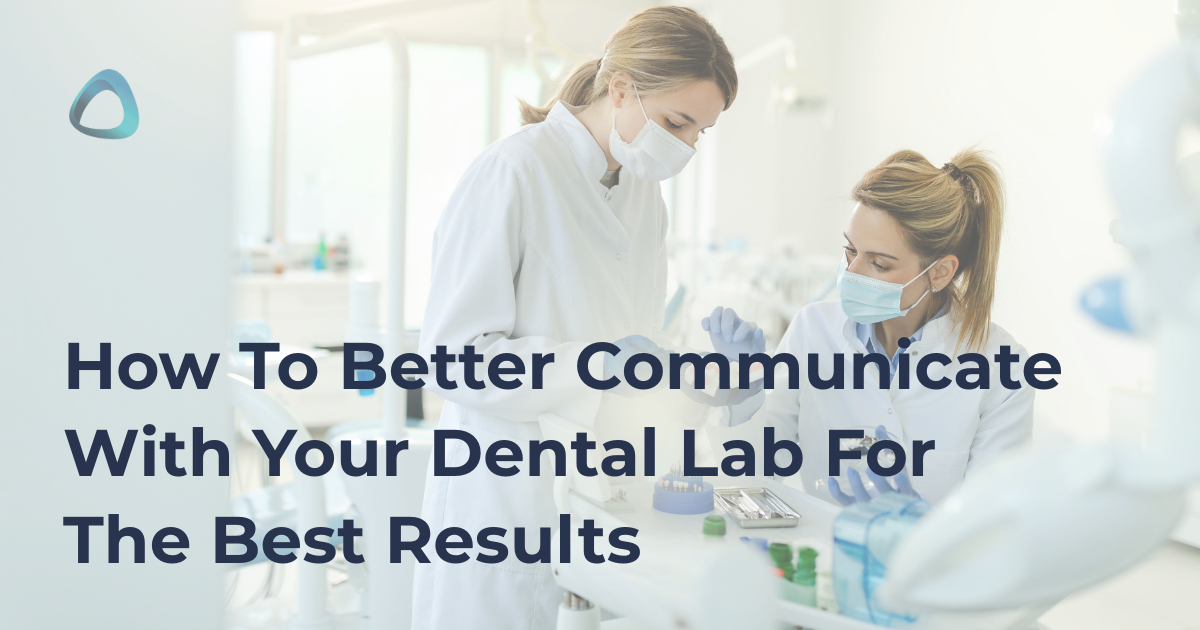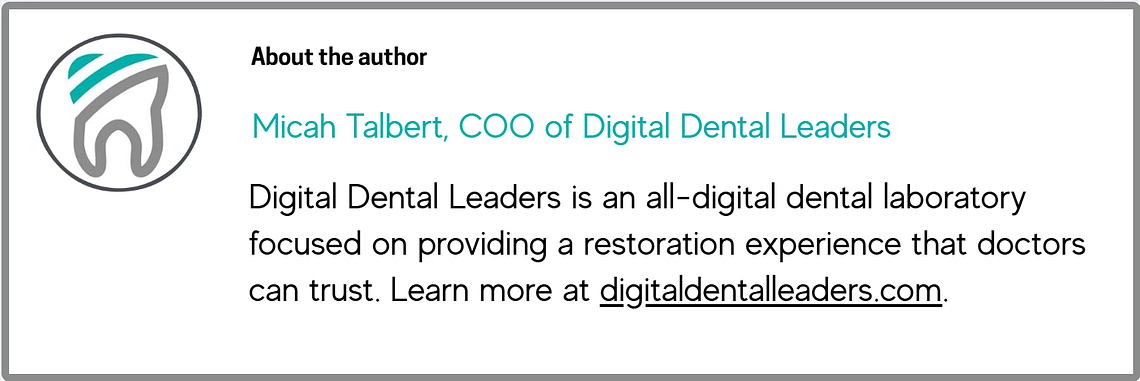Clear communication with your dental lab can be the difference between a smooth case and a challenging remake. Although in-house workflows provide numerous benefits, the vast majority of dentists scan and send to a lab for their prosthetics. Understanding how to work effectively with your lab partner is essential for predictable outcomes and patient satisfaction.
We collaborated with Micah Talbert – Chief Operating Officer at Digital Dental Leaders – an all-digital lab in the USA, to make this blog. Here are some key strategies to set your lab (and yourself) up for success, ensuring the best outcomes for your patients.
Step 1 - Know What Your Lab Needs From You
The best results start with the right inputs. Labs depend on the information you provide to produce restorations that match your expectations. Every lab and case is slightly different, but submissions typically include:
Essential Scan Data:
- Accurate and complete scans (upper, lower, and bite after checking for occlusal clearance and parallel, smooth interproximal contacts) - check out our previous post about this topic
- Pre-preparation scan if applicable/required (can be essential for smile design cases and complex work)
- Ensure adequate scan coverage, particularly in the posterior regions and tuberosities
Clinical Information:
- Tooth number(s), shade, and material type
- Clear shade photos with shade tab in proper lighting, especially for anterior cases (include multiple angles and close-ups)
- Patient appointment date for delivery, if applicable
- Detailed instructions (splinted vs single units, design expectations, contact tightness preferences, occlusal scheme)
Implant-Specific Details:
- Implant system, connection type, and platform size
- Scan body type and manufacturer
- Emergence profile preferences
- Screw-retained vs cement-retained restoration
Common Oversights to Avoid:
- Incomplete margin lines or scan artifacts
- Missing bite registration or incorrect bite position
- Inadequate tissue detail in the gingival area
- Shade selection in poor lighting conditions
- Unclear or contradictory instructions
If you're unsure what your lab needs for a particular type of case, ask! Most labs are happy to provide a checklist or preferred protocol. The more consistent your submissions, the more predictable your results.
We highly recommend creating your own checklist for each case type to ensure all appropriate steps are followed and information is gathered. Checklists are a powerful tool that help you and your team remember the simple things so you can stay focused on the more complex aspects of patient care.
Step 2 - Write good notes
Particularly on large or complex cases, take time to write comprehensive notes. Your technician cannot see the patient, read your mind, or understand the context without your guidance.
What to Include:
- The primary objective of the case (function, aesthetics, or both)
- Any relevant medical or dental history that affects design (bruxism, limited opening, opposing dentition considerations)
- Specific aesthetic preferences (tooth shape, characterization, translucency)
- Functional requirements (contact tightness, occlusal scheme, guidance)
- Any compromises or limitations in the preparation that the lab should be aware of
Visual Communication: - if there's a specific result you're trying to achieve that might be hard to visualize, consider sending:
- Reference photos from the patient's natural dentition
- Photos of the temporaries if they represent the desired outcome
- Screenshots with annotations from your CAD software
This becomes even more important in cases involving smile design or when a wax-up and trial smile have been carried out. Make sure to inform your lab of any changes your patient requests during the trial phase. Document both what the patient liked and what they wanted modified.
Step 3 - Give constructive feedback
A good lab wants and needs constructive feedback. It's the only way any professional relationship improves and becomes more efficient over time.
Effective Feedback Includes:
- What worked well (helps labs understand your preferences)
- What could be improved (be specific about anatomy, contour, shade, occlusion, contacts)
- Photos of the restoration seated, if there were issues
- Context about whether the issue was clinical, aesthetic, or functional
One office we work with used to have its own small feedback form that it would fill out for every case, mailing all completed forms to us monthly. It was a great way to gauge their seating experience and identify potential improvements to optimize their results.
Whatever method you use, ensure your feedback is clear, and make time for a follow-up call if your lab needs more information. Every clinician has their own preferences, so inform your lab how you like things done. The more they understand your style and expectations, the better they can deliver results that match your vision.
Step 4 - Accept feedback from your lab
Your lab lacks your clinical perspective and chairside experience, but it has extensive experience designing and producing tens or even hundreds of thousands of cases. They see patterns across many practices and can offer valuable insights.
What Labs Can Help You With:
- Preparation design feedback (taper, reduction, margin placement)
- Scanning technique improvements (common artifacts, missing areas)
- Material selection for specific clinical situations
- Design modifications that will improve longevity or function
- Workflow efficiency tips
Labs also have extensive remake data showing them the prepping and scanning styles that tend to succeed and those likely to cause issues. This accumulated knowledge is invaluable.
How to Foster This Exchange:
- Request specific feedback on challenging cases
- Be open to feedback
- Understand that suggestions are meant to improve outcomes, not criticize your work
You share a common goal of wanting cases to go as smoothly as possible. The more you collaborate to provide each other with feedback and refine your workflow, the better your results will be.
Step 5 - Establish a Preferred Communication Channel
Different situations require different communication methods. Establish with your lab which channel works best for various scenarios.
Communication Methods and Best Uses:
For Routine Cases:
- Lab software messaging systems or scan notes
- Email for non-urgent questions
For Complex Cases or Clarifications:
- Phone calls for real-time discussion
- Video calls to review designs together (especially valuable for complex cases)
- Screen sharing to walk through digital design decisions
Digital Tools to Leverage:
- Many modern scanner systems now integrate directly with lab software
- Medit Link Express and similar platforms allow seamless case submission
- Cloud-based CAD platforms like DS Core enable collaborative design review
- Consider using case management software that allows both parties to track case progress
Having a clear understanding of when and how to reach your lab can save crucial time and prevent miscommunication on time-sensitive cases.
Bonus - Building a Long-Term Lab Partnership
The best lab relationships are built over time and through consistent collaboration. Consider these strategies:
Select the Right Lab Partner:
- Look for labs with expertise in your case types
- Evaluate their technology and digital capabilities
- Consider their communication responsiveness
- Ask about their quality control processes
Invest in the Relationship:
- Visit your lab if possible to understand their process
- Collaborate on challenging cases as learning opportunities
Maintain Consistency:
- Use the same lab contact when possible for continuity
- Keep your protocols and preferences documented
- Update your lab when your techniques or preferences change
- Be loyal to labs that deliver quality and value your partnership
The Bottom Line
By delivering exactly what your lab needs for each case type, writing clear and detailed notes, both giving and accepting feedback, establishing efficient communication channels, and investing in the relationship, you will significantly reduce stress and remake rates while increasing patient and lab satisfaction.
Remember - your lab is not just a vendor. They're a partner in patient care. The time you invest in building this relationship will pay dividends in predictable outcomes, reduced chair time, and happier patients.
Great lab communication isn't just about avoiding problems—it's about creating a collaborative workflow that elevates the quality of care you can provide. Start implementing these strategies today, and watch your lab cases become more predictable and satisfying for everyone involved.


